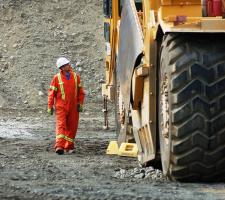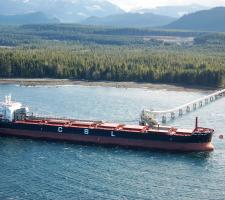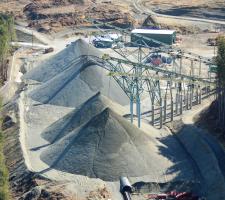
Canada's west coast is home to one of the newest super quarries in North America, which is helping to meet aggregates demand in the US. Claire Symes reports on the rapid development of the Orca Quarry
Aggregate demand on the US west coast is fast outstripping regional supply capabilities and importing material from neighbouring countries is becoming essential. This trend has led to development of new port facilities in the US and prospecting for potential new quarry sites on Canada's British Columbia (BC) coastline to meet the demand.
Polaris' Orca Quarry is one that has been recently developed just to serve the market for aggregates in the US and production is expected to reach 6million tonnes in the next year. The site near Port McNeill in BC is not only one of the newest super quarries in North America but is also one of the largest sand and gravel quarries on the continent.
Extraction at the site started in February 2007 - less than 12 months after work started on site - and the aggregates are transferred from the site via conveyor to a specially built sea terminal. Facilities at Orca are capable of loading 72,000tonne ships which transport the material to various ports on the west coast of the US.
Land rights
The size and rapid development of Orca belies the complexity of the project which Polaris has successfully undertaken. While British Columbia may be resource rich, land ownership and environmental issues mean that developing a new quarry is not straightforward. Nonetheless, Polaris has taken a fresh approach to the problems and has successfully managed to get the Orca Quarry up and running in a very short space of time.
"Polaris was set up in 1999 with the sole aim of finding potential aggregates projects on the west coast of Canada to supply aggregates to the US," said Polaris chief operating officer Herb Wilson. "The first few years involved searching for sites, then once these had been identified we had to negotiate access, gain permits and complete public consultations and establish a market for the material, which all takes time." Gaining permission to open a new quarry is not a simple process anywhere in the world but Polaris had some particularly complex issues to resolve before the location of the Orca Quarry could be finalised.
"Land ownership in BC is very different from that in Europe," explained Wilson, who was born and started his quarrying career in the UK. "In BC, no single person can own the land but it falls to different bands of First Nation people to have stewardship of it. This makes negotiations to gain access to mineral resources very complicated. At Orca, two bands have overlapping claims, which on paper could have made things very difficult but our president has a philosophy of working with the First Nations.
"In the early stages of looking at the potential site for the quarry we asked the two bands of First Nations in the region to identify any areas that we could not quarry. We did not ask for a specific reason, just guidance on which areas may be acceptable and then took the negotiations from there." Polaris wanted to ensure that both bands had the opportunity to be involved and benefit from the project. One band, the Namgis, is a minority (12%) shareholder in Polaris and has people working at the site with work hours planned around ferry times from their nearby settlement. The other band, the Kwakuitl, also has people employed at the quarry and has an Impact and Benefit Agreement with Polaris. Both bands also have representation on Polaris' board of directors.
"BC is a resource based economy which has helped the project gain acceptance in the region," said Wilson. "The local area relies on logging and fisheries for employment but with both industries going through difficult times, and the closure of the world's largest copper mine in the region in 1996, there is a readily available work force for Orca." With access to the resource in place, Polaris secured a long term supply agreement with Shamrock in 2006 for delivery of materials to California, which green lighted the Orca project. To help fund the project Polaris went public and work on preparing the site stated in April 2006 with the first aggregates extracted in February 2007.
Since starting extraction at the site, Polaris has also secured a long term supply agreement with
"The agreements with Shamrock and Cemex, as well as our other contracts in California mean that the market for our material is opening up and will continue growing," said Wilson. "Even with concerns about recession in the US, we are confident that our market will continue to grow, as many quarries in the western seaboard do not have enough reserves to meet demand. In the area around Los Angles there are some very large sand and gravel quarries but many only have enough reserves to operate for another 10 years at current demand levels.
"Good sand and gravel resources do exist in California but due to the rapid urban development, many of these sites can no longer be considered viable for extraction. In the future quarries such as Orca will be the only way to meet the US demand for aggregates."
Forest foundations
The area that Polaris currently has permission to quarry covers 175ha, with the actual extraction site occupying 15ha. "There are 125million tonnes of sand and gravel within the existing permission area which gives Orca sufficient reserves for the next 25 to 30 years," said Wilson. "But the opportunity to extend the quarry in the future also exists, which could allow extraction at a rate of 6million tonnes per year for the next 100 years." Until arrival of the quarry, the area was used for forestry and the extraction has been planned to allow the area to be progressively restored back to its original use. "Reclamation will start at the end of year four with stripped overburden being placed on the first extraction area and replanted with trees to return it to commercial forestry," said Wilson.
The sand and gravel at Orca is formed by glacial outwash that has been reworked by two periods of glaciation and as a result is very clean with a low clay and silt content. This high quality made the resource ideal for Polaris because it requires minimal processing, enabling the company to keep production costs low.
The deposit is formed in two layers with the upper layer made up of coarse gravel - from well sorted volcanic, and igneous particles - and sand with the lower layer mostly fine sand. The whole sand and gravel bed lies on top of the sandstone bedrock.
"The aim is to extract the material down to either the point where the sand becomes too fine or 5m above the groundwater level, whichever comes first. The extraction regime is planned to avoid creating a lake at the quarry and allow the area to be reclaimed for forestry," said Wilson. "The rainfall at the Orca site is very high - up to 1.8m per year but the deposit is very free draining, so the groundwater doesn't fluctuate too much. The abundance of water at the site has meant that all of the water needs for processing the aggregates can be met from our own boreholes at the site." Aggregate extraction at the site is carried out by two
"The scrapers are ideal for the work at Orca," said Wilson. "The deposit has no large boulders - the largest particles are around 200 to 220mm in diameter but mostly the gravel is less than 150mm across. It is also very loosely consolidated, although initially we were concerned that this might make the material too soft and cause traction problems."
Concrete focus
The dump hopper used at Orca was specially designed for the quarry by a local engineering company. The hopper has a modular design, which will allow Polaris to dismantle and relocate it close to the extraction area from when necessary and extend the conveyor to deliver the material to the fixed processing plant.
The clean nature of the sand and gravel at Orca means that the raw material can be dry screened. Any material over 25mm is passed through a
Sludge from the sand classification process is treated with thickeners and passed through filter presses to reclaim the water to allow for reuse within the processing plant.
"Our whole production process is geared around the sizes of aggregates used in US concrete production," said Wilson. "We are not trying to be all things to all people but have focused on the concrete market in a bid to minimise production costs. The gravel and sand is split during production because it is stored in four stockpiles - one each for the gravel sizes and two for sand. We do this because each of the stockpiles is capable of storing 150,000tonnes of material and if it was mixed before storage, then segregation would occur. The material is remixed and blended as it is loaded onto the ships."
Ship to shore
Orca is designed to have a large inventory of materials in order to have sufficient aggregates to load the 72,000tonne capacity ships which Polaris uses to transport the material to the US market. "Our ship loading facilities are capable of loading a 72,000tonne ship by gravity alone in less than 20 hours," said Wilson. "That volume is equivalent to around 3000 highway trucks." Orca currently loads around two or three ships a month but at its peak, the quarry expects that to reach two a week. Polaris has a long term agreement with CSL for marine delivery of its materials to service its agreements with Cemex, Shamrock and to meet the needs of the company's own terminal in San Francisco.
"The ships we use are self discharging vessels, which can unload at a rate of 5000tonnes per hour," said Wilson. "Fully laden, the ships are too low in the water to dock at our San Francisco port, so they are scheduled to stop outside the port and discharge around 30,000tonnes of material directly into our customers' barges before docking. This not only means that we do not need to have deep water port facilities but it also reduces the time the ship is in port and minimises the docking fees." The deep ocean ship loader at Orca is located 550m offshore and is formed by a conveyor mounted on pilings. This CAN$25million (€16.8million) investment represented a considerable amount of the cost of setting up the Orca quarry and also required a great deal of environmental planning.
"In the summer season the whole region becomes a tourist area with up to 40 ocean-going liners using the inside passage each week and smaller boats for orca and humpbacked watching trips passing the loading facilities," said Wilson. "Throughout the development the focus was on minimising the impact of the quarry. We have maintained the trees around the conveyor, so from the water the only part of the quarry that is visible is the ship loader. All the plant within the quarry has been painted green to blend in with the forest and the trees also provide good sound deadening for the quarry.
"Because of the bedrock below the ship loader, we had to use Oslo Tips for the piles but there was some concern about the impact of this work on the activity of the whales in the area. We planned to use drop hammer piling techniques to minimise the vibrations created but when the work was underway, the orcas and humpbacks were actually playing around the piling rig and were more interested in catching seals." The route of the conveyor through the forest was also planned to avoid the kelp beds on the foreshore and other environmental features. "We opted to raise the whole conveyor up on piles to minimise the impact," explained Wilson. "Using a rock fill embankment would have been quicker and cheaper to install but over the water sections it could have restricted salmon and orca migration patterns." Orca quarry is lucky not to have any immediate neighbours so have no restrictions on hours of operation and no noise issues to deal with. The quarry itself operates a 10hour shift but the ship loading is a 24hours, seven days a week operation. "We know roughly when a ship will arrive but the actual time will be weather and tide dependent," said Wilson. "However, the more time it is waiting to be loaded, the more it costs us, so whenever the ship arrives we try to start loading straightaway."
Safety matters
Despite the long and sometimes erratic working hours at Orca, the quarry has maintained an exemplary safety record. Polaris even won an award for the set up of the quarry when it achieved more than 100,000hours without a lost time accident - no mean feat with up to 18 contractors on site at any one time.
Since set up the focus has been on training its workforce to a high level and Polaris has delivered more than 6000 training hours in the first year to its 30-strong workforce. "Many of our employees from the local communities and the First Nations have never worked in a quarry before," said Wilson. "Starting training from scratch with this part of our staff has been good because none of them have any bad habits and we have been able to take a fresh approach to health and safety training."
Costs benefits
Despite the high cost of shipping, Polaris must be making a good profit from its Orca quarry but Wilson remains tight lipped about the actual price the material achieves in the US market. "All I can say is that we dispatched a ship to Hawaii recently and the invoice for the material was in excess of US$1.25million (€0.85million)," he said. "Shipping costs represent around 30 to 50% of the final price of the aggregates." On the subject of cost of production, Wilson is more forthcoming and quotes figures produced by the quarry's feasibility study that was carried out by
Gearing up
From April this year, Polaris will introduce a second shift to the operation at Orca which will allow it to reach its target production of 6million tonnes. The expansion of operation at the quarry will take the workforce at the site up to around 50 people. The company has also had a third Cat scraper on order ready for delivery in March to coincide with the ramping up of production.
Wilson said that Polaris is already considering placing an order for a fourth scraper and will also invest in other efficiency improvement at Orca over the next year or so. "After operating the site for 12 months, it has become clear that while the quarry is very efficient there are changes that could be implemented to further reduce operational costs," said Wilson.
While Polaris has been very successful with the development of Orca, it is not resting on its laurels and is working on development of a hard rock quarry at another site in BC. According to Wilson, the Eagle Rock granite quarry in South Vancouver will allow the company to also supply aggregates for the US asphalt market. Feasibility studies for the site are expected to be completed this year and with the necessary US$100million (€68million) financing in place during 2009, Polaris hopes to break ground at the site during late 2010.
"The new hard rock quarry has reserves of more than 750million tonnes of very high quality granite," said Wilson. "Like Orca, ownership of Eagle Rock will be split between Polaris (70%) and First Nations (30%)."

















